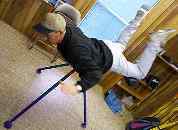
Dropping Class
The six-hour, USPA Accelerated Freefall I class at Westpoint Skydiving takes us through every step of an actual skydive, step by step, over and over. Each step may seem easy to you, but then, it wasn't your butt falling at 120 mph, was it? Screwing up on this assignment will cause serious pain, and this class is all about avoiding pain.
Before last week, skydiving was only a pipe dream for me, until one of my readers helped get me into this class. The two other students in my class, Eric Leasure and Jason Black, are engineering majors at Penn State University. One day, they tried to think of "what could be the complete opposite of this boring engineering course?" - they came up with skydiving. They selected Westpoint (6 hours away) out of many they saw on the internet, because it "allowed for the longest freefall time," Leasure tells me.
I meet Jim Wade, who drives two hours, and passes two dive zones, to jump here. (Wade makes peanut butter for your Reese's cups at the Hershey factory, and he completed the AFF program here last year.) He keeps coming back because "They are very professional here," he says. "If I have a question, someone will sit down with me and answer it until I understand."
This airport was used in WWII to send airplanes to Europe. A dive club was organized in the 1960's, and the school was opened in 1990. Benny and Terry Sherman bought the school in 1995 "as a way to subsidize my skydiving," says Benny Sherman, who works route sales during the week, and has "always had a fascination with flight." He earned his pilot's license in 1994, but never got quite comfortable with flying a plane, at least not as comfortable as jumping out of one. He has intentionally jumped out of more than 2,200 of those airplanes and is still alive to show me how to do it, so I am pretty comfortable with him.
 Benny Sherman will teach the course today and first, he shows us how to fly. In the classroom, he gets us to arch our backs and hold our arms and legs out. Keeping an arched back is important because it keeps us with our parachutes up and our eyes down. We practice this several times.
Benny Sherman will teach the course today and first, he shows us how to fly. In the classroom, he gets us to arch our backs and hold our arms and legs out. Keeping an arched back is important because it keeps us with our parachutes up and our eyes down. We practice this several times.
The
JUMP - We leave the classroom for a while and walk to the hanger, under heavy cloud cover. The weather is supposed to clear up today, but for now, it is cold and ugly outside and there is a chance we may not get to jump.
We climb aboard the Beechcraft, 13 passenger, twin-engine, King Air - our boost for the day. Sherman shows us how to jump out of the plane, which for each of us, will be a coordinated effort involving three people. I will stand in the doorway, with one instructor outside the plane, holding onto a rail, and one inside the plane, holding onto me. I will have very little to hold onto as I step out here, with the plane hauling along at over 100mph, nearly 3 miles above the Earth, and I think about how these cheapskates could bolt a little handle to the fuselage, when Sherman explains that there is no handle for a good reason; he doesn't want me clamping my hand onto anything, because I might just change my mind and panic, and given the forces of two men, the 100 mph wind and gravity, I might just leave that hand behind.
The
FALL - Back in the classroom, we learn a skills exercise that we will perform in freefall, which involves checking our altimeters, making eye contact with our instructors and locating our ripcords. Things start to get serious. I concentrate on this so hard that I blow it several times, and I start to worry about today. I am on a writing assignment, and I have to focus on that, but I really have to concentrate on this class. I miss several good photographs through the day, and I decide that the class comes first and the article second - I want to be around to write it.
 The
The
PULL - Sherman shows us how to pull our ripcords, and how our canopies will deploy. The cord is actually a short, stiff cable that is not actually attached to anything, and it comes right off in your hand, like pulling a cotter pin. We are told that if we drop the cord, we're out fifteen bucks. Not that the cord costs that much, but this is a deterrent to letting the thing fall out of the sky onto somebody's new Buick.
The
GLIDE - We go outside to the rigging simulator. The Sun is working its way through piles of clouds, and we are encouraged. I put on a harness, and Sherman hangs me on the simulator and has me pull a set of straps, called toggles, which I will use to steer. He spins me around a few times to show me what it's like to have tangled lines. This is not uncommon, he says and explains how getting untangled is like playing on a swing set. I have this mastered already and I kick my legs and pull myself straight.
The
CRASH - Back inside, we watch what I call the "Titanic" video. This shows us what can go wrong (or malfunction, as they call it) and how to react if it does. Sherman tells us how to land in trees, how to plow through fences (use your feet) bounce off a car, avoid powerlines, how to land in water and inflate our PFDs. He tells us this because even though there is very, very little chance that any of this will happen, if any of this does happen, we are the only ones who can do a darned thing about it. He explains how to use our reserve chutes, how to untangle two chutes, and how to remain calm as we plummet to Earth at over 100 miles per hour. That is the unnerving thing about skydiving. Everything is designed to go right - and it usually does - but when something goes wrong, your very life is now a duel between little you and a very, very big rock.
The
LANDING - Once again, we go outside under a beautiful, clear sky to the jumping platform. Sherman shows us how to do a "Parachute Landing Fall" where we keep our hands and knees together, absorb the impact rather than try to prevent it, and roll to one side, like we're fainting. This is incredibly easy and I blow it each time. Leasure and Black glide right through it.
The
TEST - In the classroom again, Sherman gives us a few pages of questions covering the subjects we learned today. We review them and then answer them on our own.
Skydiving is one of the few sports that is over - one way or another - in a few minutes. No other popular sport has such a strict(!) time constraint. I am a more methodical person, I have found, and I can usually parse problems down, analyze them and solve them - I do well on written exams and not so well on oral. This is why I'm a writer and not a trial lawyer. I suck at competitive sports and usually choke when the heat is on. Something which is made very clear to me today is that it may get really blasted hot up there, and that skydiving is not a written exam.
It's about 3 p.m. Black will take the first plane up, then Leasure, then me. I would love to get this over with, but that's the breaks. Then someone comes in for a tandem jump, and I get bumped two flights back. I wish I had a handful of Tums.
The
WALK -
 7 p.m. and time to get ready. At least I've been able to rehearse my drills. I am entranced through the suiting up, as Crouch and Dudley practically put all the gear on me, and they review everything calmly and efficiently. Terri Sherman posts my flight manifest on the board, and I realize that this thing is really going to happen. I make some feeble jokes to distract myself, and the crew joins in - they're great at feeble jokes. We pose for a photograph outside the classroom, and walk the 55 paces to the waiting King Air. Dudley and Crouch test me on hand signals and have me run through the drills again.
7 p.m. and time to get ready. At least I've been able to rehearse my drills. I am entranced through the suiting up, as Crouch and Dudley practically put all the gear on me, and they review everything calmly and efficiently. Terri Sherman posts my flight manifest on the board, and I realize that this thing is really going to happen. I make some feeble jokes to distract myself, and the crew joins in - they're great at feeble jokes. We pose for a photograph outside the classroom, and walk the 55 paces to the waiting King Air. Dudley and Crouch test me on hand signals and have me run through the drills again.
The
CLIMB - We are the first ones in the King Air, as we will be the last to "depart." Everyone boards and we take off. There are 13 divers packed in along two benches and on the floor, in two groups. My group is up front; Crouch and Dudley, two videographers - Michael O'Neal and Deana Fantom - and myself. Behind us, near the door is a rowdy group of veteran divers who have absolutely no respect for the bundle of nerves sitting in front of them. During the entire climb, they laugh and joke and describe horrible accidents, and just when I decide that I'm gonna throw these punks out of the stupid plane, they open the door and jump out.
 That's it - now it's my turn. Tim Dudley turns on my radio, and gives me my goggles and helmet. Then he gets up and goes to the doorway. I watch as he instructs the pilot toward a good spot. He looks at me and smiles, then climbs out onto the outside of the plane.
That's it - now it's my turn. Tim Dudley turns on my radio, and gives me my goggles and helmet. Then he gets up and goes to the doorway. I watch as he instructs the pilot toward a good spot. He looks at me and smiles, then climbs out onto the outside of the plane.
All my sorry life I have wondered what it would be like to skydive, but I have avoided it - no excuses. All this past week, since Granger Gilbert emailed me with this absurd story idea, I have been in great anticipation. All day, as I foundered through class amid self-doubt and uncertainty, and especially during the past few hours of an agonizing wait, I have nearly dreaded this moment. I have hung in there because of my faith in this team of instructors, and because a great, little part of me loves that dread, and right now, there is nothing between me and this most terrific challenge of my life. There is nothing between me and all my dreams, but an open door, and so I stand up and walk right toward it.
What's next? Follow Mark on The WAY Down
ASDA AFF Class I provided by
Westpoint Skydiving Center
Visit their WEB SITE
